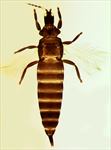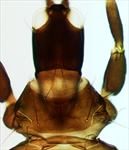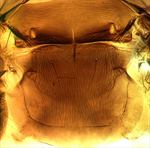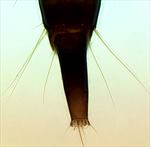
Female

Antenna

Head & pronotum

Mesonotum & metanotum

Pelta & tergite II

Hind tibia & tarsus

Male segments IX–X (tube)

Fore wing
Both sexes fully winged. Body and legs blackish brown, antennal segment III sharply yellow; major setae brown, tergite IX setae paler; fore wing deeply shaded around sub-basal setae, with median longitudinal dark line extending to shaded distal area. Antennae 8-segmented; segment III with one sense cone, IV with three sense cones; VIII slender and constricted at base. Head slightly longer than wide, ocellar region overhanging interantennal projection; maxillary stylets retracted to eyes, close together medially; post ocular setae longer than dorsal length of eyes with apices softly pointed; mouth cone extending between fore coxae. Pronotum with five pairs of long major setae with rounded apices, posteroangular setae almost as long as median length of pronotum, epimera with a second pair of stout setae variable in length; epimeral sutures complete; prosternal basantra not developed, ferna present, mesopresternum divided into paired lateral triangles sometimes meeting medially. Fore tarsus without a tooth. Metanotum reticulate, median setae long. Fore wing parallel sided, with about 18 duplicated cilia; three sub-basal setae sub-equal in length. Tergite IX setae S1 finely acute, about as long as tube.
Male similar to female; tergite IX setae S2 as long as S1; sternite VIII with an extensive pore plate.
P. varicornis, the Hollyhock thrips, was transferred from the genus Liothrips by Mound et al. (2010) because the males have setae S2 on the ninth tergite long and slender as in females, whereas all species of Liothrips have this pair of setae short and stout. In this and several other characters it resembles the Central American species, P. avocadis and P. perseae, but differs in the color of the fore wings and length of the antennal segments. Currently the genus Pseudophilothrips comprises 13 species from the Neotropics, and of these only varicornis extends northwards into California.
The bright red larvae occur in colonies on stems and leaves of hollyhocks (Althea), resulting in feeding lesions (Bailey, 1938). There are multiple records from species of Althea, Hibiscus, Sida and Sphaeralcea [Malvaceae].
Recorded from California, Mexico, Bahamas, Hawaii, and Tahiti.
PHLAEOTHRIPIDAE, PHLAEOTHRIPINAE
Pseudophilothrips varicornis (Hood)
Liothrips varicornis Hood, 1912: 74
Bailey SF (1938) Thrips of economic importance in California. University of California College of Agriculture Experimental Station 346: 1–77.
Cott HE (1956) Systematics of the suborder Tubulifera (Thysanoptera) in California. University of California, Berkeley, Publications in Entomology 13: 1–216.
Hoddle M, Mound LA & Nakahara S (2004) Thysanoptera recorded from California, USA: a checklist. Florida Entomologist 87: 317–323.
Mound LA, Wheeler G & Williams DA (2010) Resolving cryptic species with morphology and DNA; thrips as a potential biocontrol agent of Brazilian peppertree, with a new species and overview of Pseudophilothrips (Thysanoptera). Zootaxa 2432: 59–68.
Stannard LJ (1957) The phylogeny and classification of the North American genera of the sub-order Tubulifera (Thysanoptera). Illinois Biological Monographs 25: 1–200.
Stannard LJ (1968) The Thrips, or Thysanoptera, of Illinois. Bulletin of the Illinois Natural History Survey 29: 213–552.